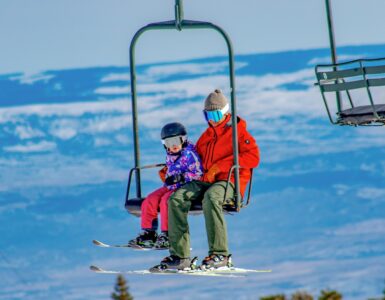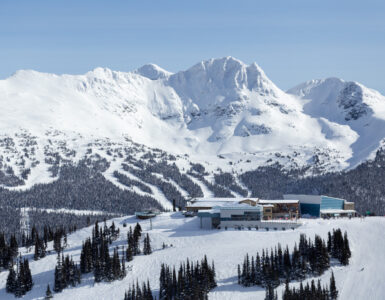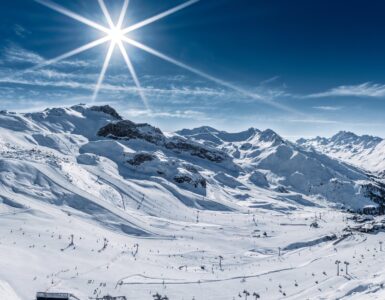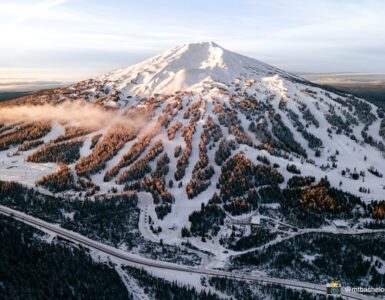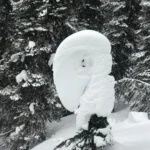Even among the world’s most polished ski resorts, Deer Valley—with its vast carpets of flawlessly groomed snow spread across four Utah peaks—was always conspicuously clubby. Skiers can pick up a free copy of the Wall Street Journal on their way to the fire, while instructors eat lunch in separate employee cafeterias, lest they mingle with the guests. “The idea was to replicate the service and experience of a five-star hotel,” says Bob Wheaton, who ran the resort for 22 years before stepping aside in January.
But when the lifts started cranking this season, things looked a little different. Among the affluent families were young couples and packs of Salt Lake City friends navigating the runs for the first time. The reason: Deer Valley had suddenly become a bulk-buy product. In 2017 a new conglomerate (later dubbed Alterra Mountain Co.) bought 11 of America’s most popular ski resorts and teamed with dozens more mountain owners to honor a single-season lift ticket called the Ikon Pass. Compared with buying a string of daily lift tickets for as much as $200 a pop, the Ikon Pass (which ranges from $599 to $899) can pay for itself in as few as three days. Only one other product is in direct competition with Ikon: The Epic Pass from Vail Resorts Inc. admits skiers to its aggressively expanding chain of 20 destinations including the company’s namesake ski area in Colorado’s Rocky Mountains.
Together, Alterra’s and Vail’s passes can be swiped at 58 North American resorts, as well as a handful of resorts in Oceania and Europe. The two competing conglomerates are trying to turn occasional skiers into frequent skiers and frequent skiers into serial skiers who incidentally buy a lot of midmountain beers and slopeside hotel rooms. Deer Valley and resorts like it have become a sort of research and development lab forecasting possible futures for the long-struggling ski industry.
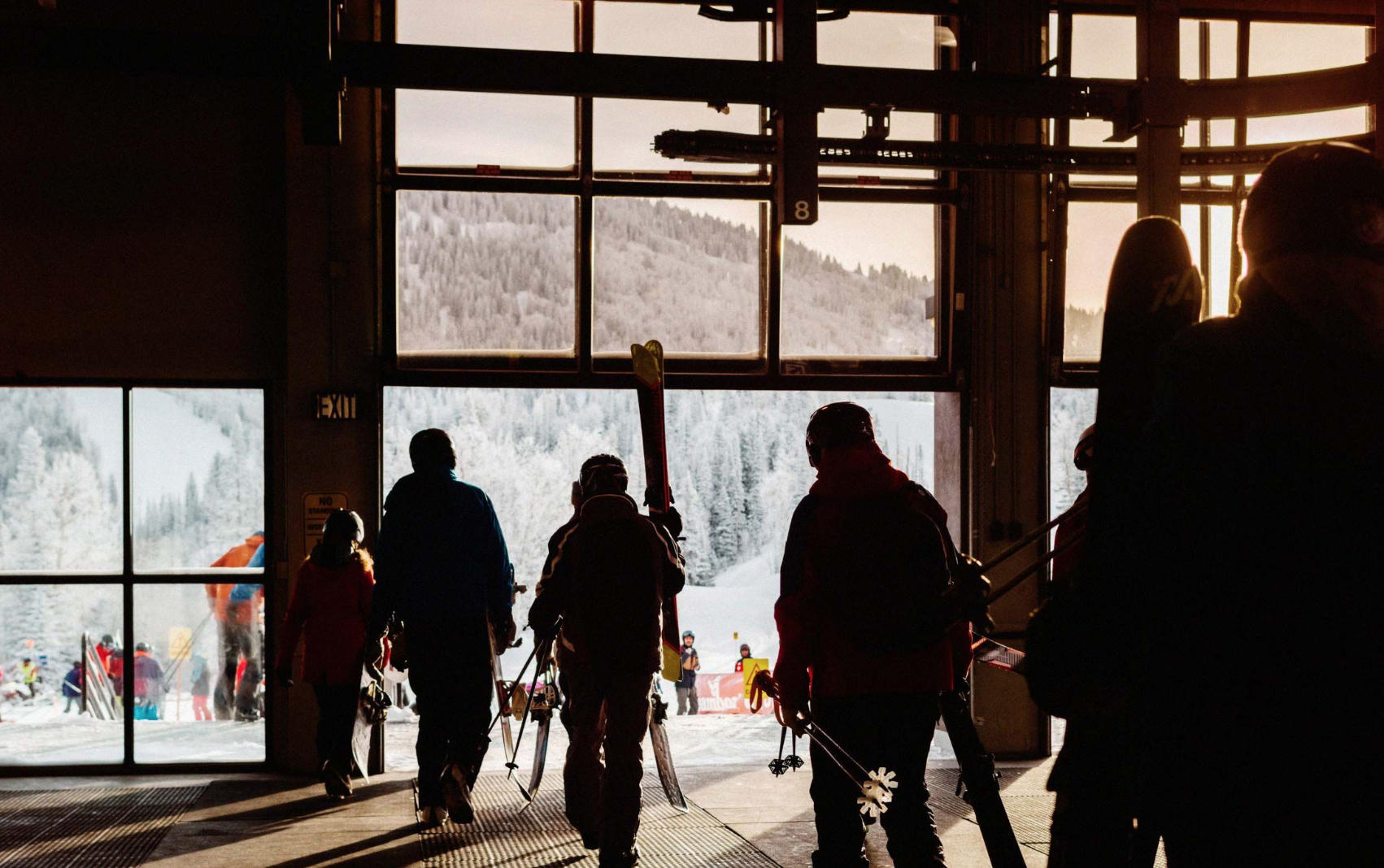
Skiers head for the slopes at Steamboat, part of the Alterra network of properties.
Skiing isn’t necessarily a bad business—it’s just lumpy and volatile, given natural cycles both economic and meteorological. (Industry lifers jokingly refer to it as “snow farming.”) As a result, ski resorts have historically attracted two types of owners: affluent families willing to ride out some tough years and investors looking to leverage chairlifts to sell condos. But in 1997, a third approach emerged when Vail Resorts bought nearby Keystone and Breckenridge in Colorado for $310 million and prepared an initial public offering. The plan was to make skiing a viable business on its own rather than a convoluted real estate gambit. Vail would buy ski areas and improve them, attracting more (and more affluent) skiers.
In 2008, Vail introduced the Epic Pass for unlimited lift rides at all of its (then five) resorts for $579, roughly one-third the cost of other existing passes. In providing such an inexpensive end run around daily lift tickets, Vail seemed to be leaving money on the table. But there was an important catch: Pass sales were offered only before the season hit its stride, closing right before Thanksgiving. By getting skiers to buy early, the company locked in a mass of customers and raked in a pile of revenue during its slowest months. Its season-pass revenue increased 22 percent in the first year, from roughly $78 million to about $94 million.
Much of the strategy came from Rob Katz, a square-jawed graduate of the Wharton School and a rising star at Apollo Management LLP, the private equity firm that bought Vail out of bankruptcy and steered it onto the stock market. As a New York native, Katz had learned to ski on Hunter Mountain, a few hours north of Manhattan, and as Apollo’s winter sports enthusiast he’d slid onto the Vail board in 1996, at age 29; 10 years later, he’d taken the chief executive officer job.
Gradually, Vail added resorts in different regions of the country as a hedge against weather. If Colorado’s Rockies were snow-starved, the company could make up the difference in California’s Lake Tahoe region or Utah’s Wasatch Mountains. By 2017, Vail had 13 properties, including Whistler Blackcomb in British Columbia, one of the most trafficked resorts in North America. The cost savings weren’t great; Vail couldn’t share much equipment or staff between mountains. But there was a revenue upside—as the empire grew, it enjoyed a network effect. Epic Pass holders traveled across the country, from Afton Alps in Minnesota to Heavenly in California, while still staying at Vail properties. Independent resorts teamed up in various alliances to sell season-pass products, but these rickety coalitions changed from year to year and never kept pace with Vail.
In the 10 years since Vail began selling the Epic Pass, its shares have nearly quadrupled. Last year, despite anemic snowfall, the company still got almost half of its revenue from lift tickets. For every daily visit by a skier, it collected $168 and paid only $135 in expenses, a 20 percent profit margin. “It’s been the ultimate Teflon stock,” said Stifel Financial Corp. analyst Brad Boyer. In response, virtually every ski executive drew up a plan to either join up with or compete against Vail. Among them was Rusty Gregory, CEO of one of the country’s busiest resorts, Mammoth Mountain.
Gregory first clicked into a pair of skis a couple of weeks after finishing a final season as a University of Washington linebacker. He put off graduate school to help skiers onto lifts at Mammoth. “I was probably the most gregarious liftie on the mountain,” he says. Gregory befriended Mammoth owner Dave McCoy and was soon welding lift towers. Eventually he ran human resources and negotiated with investment bankers to sell the resort twice, most recently to Starwood Capital Group, a private equity firm. Now, with a 15 percent ownership stake, he lives at the Four Seasons Hotel Denver with his camper van parked out front. (It won’t fit in the hotel’s garage.)
Gregory squeaked through the Great Recession more bullish on skiing than ever. Even though people stopped buying slopeside condos, they kept coming to ski. In 2016, having weathered the worst of the storm, the industry’s private equity owners wanted an exit. Starwood Capital was looking to sell Mammoth and its sister resorts, Big Bear and June, and Fortress Investment Group LLC was trying to offload its majority stake in Intrawest Resorts Holding Inc., a conglomerate of seven mountains that Vail had soundly whupped. It was a rare opportunity: 10 of North America’s most popular winter playgrounds on the block at the same time.
Ever the gregarious liftie, Gregory suggested Starwood Capital join forces with the Chicago-based Crown family and KSL Capital Partners LLC, a private equity firm led by two former Vail executives. “It was the kind of thing that probably wouldn’t have happened if we hadn’t been casually drinking beer together for years,” he says. The descendants of the industrialist Henry Crown owned a number of Colorado resorts known for fine dining and being favored by celebrities. KSL Capital, which owns California’s Squaw Valley, had previously worked with the Crown family on developing Aspen Snowmass in Colorado. In April 2017, KSL and the Crowns bought Intrawest for $1.6 billion and folded in Mammoth, Big Bear, June, and Squaw Valley on undisclosed financial terms. David Perry, longtime chief operating officer of Aspen Skiing Co., took command of the deal, with Gregory as a close confidant. Both men knew size would equal safety, so they began calling their buddies, which eventually led to the formation of Alterra.
In October, Alterra invited leaders of the continent’s largest non-Vail resorts to New York City’s Gansevoort hotel. Their pitch was, “If you won’t let us buy you, honor our season pass, and we’ll split the revenue even-steven.” Under the partnership agreements, a resort would be paid for each day a skier swiped her Ikon Pass—either a negotiated fee or a “blended rate” based on how many Ikon days were tallied over the course of a winter. Stephen Kircher, president of Boyne Resorts, which owns nine properties spread from Maine to Oregon, says the offer went over well, particularly among ski areas that had been fending off Vail for years. “I emailed them within about eight seconds,” he says.
Soon after, Vail started making similar calls, offering to host partners on its Epic Pass. “We were all in play,” says Jerry Blann, who was then the president of Jackson Hole Mountain Resort Corp. in Wyoming. Through the winter of 2017-18, America’s biggest ski mountains were picking sides. Jackson Hole went with Alterra, as did Sugarbush in Vermont, plus Boyne Resorts and Powdr Corp.—two smaller conglomerates comprising 18 resorts, including Montana’s Big Sky and Vermont’s Killington. By the time flurries starting falling this past fall, an additional 11 resorts had signed on to the Ikon Pass, and Alterra had purchased two more resorts.
Vail’s mergers-and-acquisitions squad was also working overtime. The company snapped up five resorts over the summer and fall of last year, including Stowe in Vermont and Colorado’s Crested Butte. Telluride Ski & Golf Resort CEO Bill Jensen went with Vail largely because it had a long track record managing a number of resorts under one season pass. He figured his mountain would lose up to 15 percent of its out-of-town business if he didn’t align with one pass product or the other. “We’re a rural place,” he says. “I have an entire community to think about, not just the ski resort.”
Wheaton, the former Deer Valley president, estimates he’d been turning down acquisition offers for the resort every two weeks for almost a decade. Most of the time he wouldn’t even bother to relay the bid to the families that owned the resort. But Alterra’s offer, still undisclosed, was on a different scale. “I thought, ‘Well, this is one I better call them about,’ ” he says. “It was like, holy s—.”
On a crisp, sunny morning in late December, a massive snow-grooming machine trundled up one of the slopes at Steamboat, an Alterra resort northwest of Denver. The rig ground to a stop on a midmountain plateau, cranked out some reggae, and started slinging Mexican food. Taco Beast, as the machine is called, is a paragon of Alterra’s approach to the ski business: a $300,000 experiment that resort managers didn’t bother running by headquarters. By 2 p.m. the food truck had sold almost $2,000 in tacos before crawling off to restock.
“We’re not selling widgets here—we’re creating experiences,” Gregory says. He claims this approach was critical in getting independent mountains to sign on to Alterra’s season pass over Vail’s. Erik Forsell, the marketing chief, says the best metaphor is the beer industry: If Vail is Budweiser, Alterra wants to be a six-pack of craft brews.
At Vail, Katz bristles at the implication that the company’s resorts are homogeneous. Sure, there’s still a small band of crusty ski-town lifers driving around with “F*ck Vail” bumper stickers, irate that their favorite lift was upgraded to a high-speed quad or some jobs were moved to Denver. But that’s a small demographic, and savings aren’t easy to come by in the ski business, Katz notes. “There are plenty of things I hear from guests that they think we should do better,” he says. “I never hear that Breckenridge looks like or feels like or gets confused with Vail or Park City or Whistler or Kirkwood or Stowe.”
One thing Vail resorts have in common, besides matching employee parkas, is technology. Every Vail pass or ticket is embedded with a radio frequency identification chip, which is automatically scanned like an E-ZPass at every one of the company’s 430 lifts. Vail knows how much, where, and with whom each guest skis. The data are used to predict how likely the person is to return to a Vail resort. It’s a Big Data play in an historically analog industry, and the machinery will only get smarter every time Vail swallows another resort.
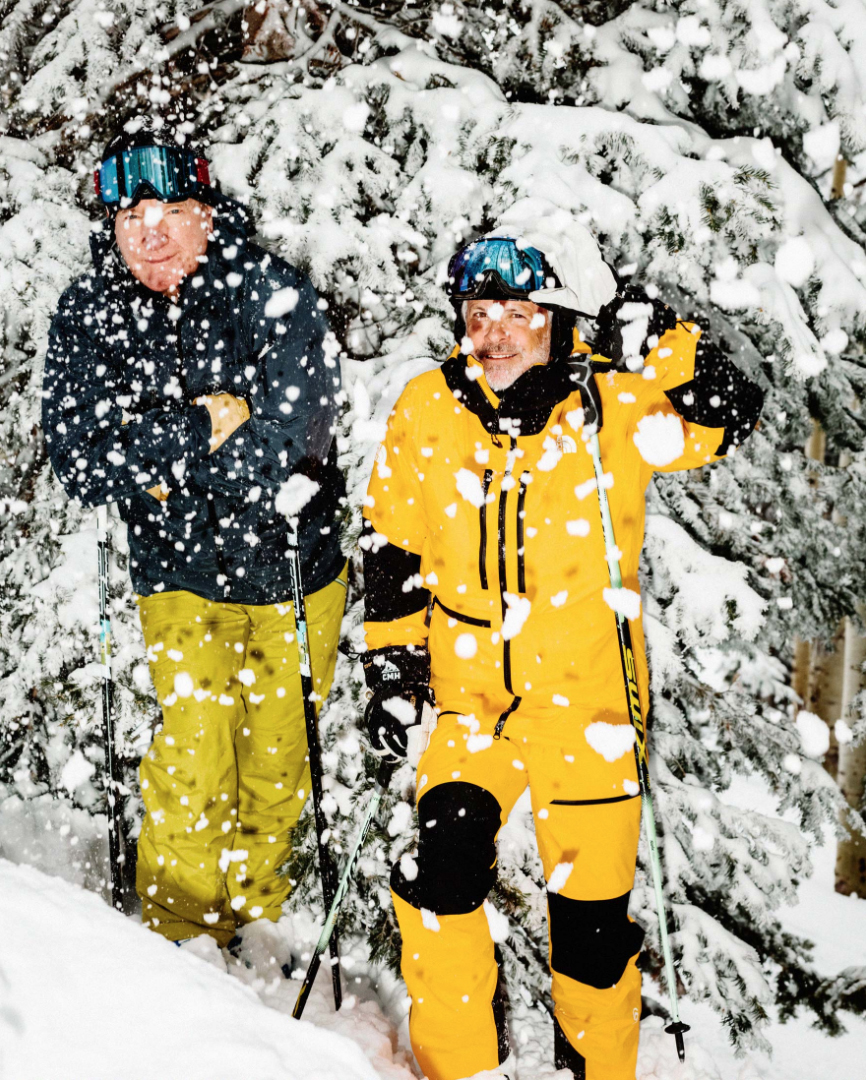 Alterra CEO Rusty Gregory and COO Dave Perry practice what they preach at Colorado’s Steamboat
Alterra CEO Rusty Gregory and COO Dave Perry practice what they preach at Colorado’s Steamboat
Right before Christmas, Alterra was still moving into its new headquarters just east of downtown Denver. Cardboard boxes and computer screens were stacked against panoramic windows framing the Front Range and a handful of breweries and weed stores. “You’ll have to excuse us,” Gregory said. “We’re kind of building the airplane as we’re flying it.” Alterra won’t say how many Ikon Passes it sold, but orders were ahead of expectations by 30 percent, and the company was on track to book $1.5 billion in annual revenue.
In a suburb 18 miles north, Vail headquarters was more organized but arguably less chipper. On Dec. 6 shares of the company had plummeted by almost 18 percent when it reported season pass sales slightly lower than expectations. A few weeks later, shares fell an additional 13 percent when Vail said it welcomed smaller-than-expected crowds leading up to the December holidays. Boyer, the analyst at Stifel, lowered his target price on Vail. “There is that ‘Eff Vail’ crowd out there, and those folks embraced Ikon from the start,” he says. “It’s definitely a competitive threat.” Even so, Vail pass sales have increased by an average of 13 percent a year for the past six years, and the company is on the cusp of selling 1 million season passes for the first time, thanks in part to a new sales program aimed at service members and military veterans.
Vail’s growth is impressive relative to the industry at large. The number of U.S. skiers (about 9 million last year) and how many days they log on a mountain (53 million) have changed very little in the past two decades, according to the National Ski Areas Association. Meanwhile, the $8.4 billion industry faces an existential crisis on two fronts: climate change’s feast-or-famine cycles of snowfall and a tide of baby boomers heading for the permanently aprés-ski scene of hip replacements and retirement homes.
Nor has skiing shed its stigma as an expensive pastime. Alterra and Vail may be exacerbating the problem as they increase daily rates to nudge people into buying a season-long lift ride. “In the eyes of a potential new skier, that’s what skiing costs,” says Evan Reece, CEO of online lift-ticket marketplace Liftopia Inc.
Reece spends his days trying to persuade resorts to price daily tickets the way airlines price seats, fluctuating constantly based on a range of factors including weather and how far in advance someone is purchasing. It’s an economically proven way to maximize value and get novices on the hill at a discount; it’s also a tough sell. Reece worries that as the industry rewards the loyalty of its core customers, fewer people will give skiing a try. “There’s some amount of the market that’s going to vaporize overnight if the industry keeps doubling down on season passes,” he says.
Katz says the focus on regulars helps the industry: “The more days we can get out of somebody, the more likely it is that they’ll continue skiing.” He says he’s heartened that participation has held stable, a contrast to the hordes of weekend warriors giving up on golf.
In mid-December, Gregory flew into Deer Valley to see how things were going. After a conference call, he loped up to the lift to meet Wheaton, who’d delayed his retirement and signed on as a sort of roaming consultant for Alterra. They’re two unlikely ski bums turned even less likely ski executives. Wheaton, a native of Detroit, is short with a rancher’s belly. Gregory, who paid for his few finance courses by welding bridges, hulks with a linebacker’s head. On the lift ride up, they were sanguine about the future of their industry. Who wouldn’t love this? they wondered, as the sun saturated the Wasatch Range. “I can tell you one thing,” Wheaton said, “we’re not done shopping, and Vail’s not either.”
Disembarking, the men tucked their chins to the wind, leaned into the descent, and carved sinuous turns with near-perfect form. In the parlance of the sport they love, they ripped, zipping past crowds of new guests at speeds that seemed almost reckless.
By Kyle Stock, republished from Bloomberg




